Eee PC 1000H Much Faster With SSD Upgrade
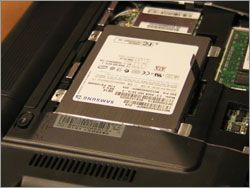
A few weeks ago, we took the 5,400 rpm Western Digital Scorpio hard drive out of the MSI Wind and replaced it with a SanDisk SATA 5000 SSD. We hoped the boot time would be better and that applications would load more quickly, but in a day or two of anecdotal use with the SanDisk SSD, we didn't notice any performance improvement. At the time, we noted that the SanDisk SATA 5000 is not a very fast SSD and that we regretted we had not had time to do any firm testing before we had to return our review model Wind to MSI.
This week, when our friends at DV Nation lent us a blazing-fast 64GB Samsung SATA II SSD, we couldn't wait to install it in our Eee PC 1000H and this time run a complete battery of real-world tests to see how much a difference a high speed SSD can make in a mini-notebook.
With the easily accessible upgrade panel on the Eee PC 1000H, we were able to swap out the system's default 5,400 rpm hard drive, a Seagate Momentus, with the Samsung SATA II in minutes. After installing a fresh copy of Windows XP Home SP2 with all the ASUS drivers and utilities, we were ready to put the system through some tests.
We opted to test the high-speed SSD-enhanced Eee PC 1000H not only against the Eee PC 1000H with its default hard drive, but also against the Eee PC 901, which has the same RAM and CPU as the 1000H but sports a smaller 9-inch screen and a pair of SSD chips as its hard drive. We wanted to see not only how much an SSD could improve the performance of the 1000H, but also how the aftermarket Samsung SATA II SSD compares to the built-in SSD chips ASUS uses on every Eee PC model except the 1000H.
We won't bore you with too many details about ASUS's SSD chips, but it's important to note that all Eee PCs with more than 4GB of storage space (900, 901, 1000) actually come with two different SSDs, with the first 4GB on one chip and the remaining storage on a slower, higher-capacity chip. We ran our tests on the primary 4GB chip to get the best performance possible.
HD Tach Tests
To get a rough idea of each hard drive's capability, we ran the quick bench test in HD Tach 3.0.4.0. Looking at the results, we were not surprised to see that the Samsung SATA II, which is rated at 100MB/s read and 80MB/s write speeds, gave transfer rates that were double that of the Seagate Momentus 5,400 rpm drive and the ASUS 4GB SSD which HD Tach detected as an "ASUS-PHISON SSD TST2.04P."
Stay in the know with Laptop Mag
Get our in-depth reviews, helpful tips, great deals, and the biggest news stories delivered to your inbox.
After all, the Samsung SATA II 64GB costs anywhere between $800 and $1,000 online and the 32GB version is in the $400 - $600 range, depending on where you find it. The entire Eee PC 901 computer costs $599 so we expected a huge performance gap between ASUS's SSD and a top-of-the-line drive like the Samsung. Nevertheless, we were surprised to see that the random access time was exactly the same on both SSDs.
| System | Burst | Average Read | Random Access |
| Eee PC 1000H (Samsung SATA II SSD) | 121.6MB/s | 93.5MB/s | 0.4 ms |
| Eee PC 1000H (default hard drive) | 126.4MB/s | 35.2MB/s | 15.8 ms |
| Eee PC 901 | 45.1MB/s | 41.1MB/s | 0.4 ms |
The real question is not how these drives look in HD Tach, but whether they make the Eee PC faster and more pleasant to use in the real world. In everyday computer use, system boot time and application launch times are extremely important to users, because the last thing anyone wants to do is sit there and wait while the hard drive light flickers.
Boot Time
We measured boot time on all three Eee PCs, by pointing a camera at the screen and filming the entire start up process from the moment our finger touched the power button to the appearance of the last tray icon. We then went back to the video and determined the time down to the tenth of the second.
There was a huge, nearly 8-second difference between the HD and both SSDs. However, the two SSDs offered nearly identical times, proving that boot time is more dependent on random access than transfer rate.

It's worth noting that there's very little one can do to make the boot time faster than 31 seconds. First of all, part of the boot process involves waiting for the system to post before Windows even starts loading and then we have to wait for all the little tray icons that the Eee PC needs like its video driver, power management application, and touchpad software.
At one point, we tried turning off a whole bunch of Windows services, disabling the WIndows splash screen, and setting our paging file to a static size, and we were able to lower the time from 31.3 to 29.7 seconds.
Application Launch Times
We used the camera again to capture application launch times for a few popular programs. All launch times were measured the first time an application was opened after booting to prevent Windows from caching parts of the program in memory.
As expected, the high-end Samsung SATA II blew away both the 901's ASUS-Phison SSD and the 1000H's Seagate Momentus. The battle for second place was more heated, with the 901's SSD opening more applications more quickly than the 1000H's hard drive, but in a few noteworthy cases, the 5,400 rpm hard drive was significantly faster.
Microsoft Word 2007
In Word 2007, the Samsung SSD was twice as fast (1.3 seconds) as the 901's ASUS-Phison SSD (2.5 seconds), but both really blew away the 1000H's hard drive. In the 9.5 seconds, it took for the Seagate Momentus to open everyone's favorite word processor, we could win a bull riding contest.
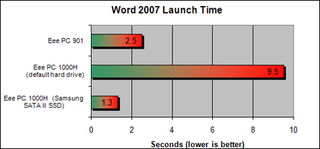
Adobe Premiere Elements 4.0
As we expected, the Samsung SSD blew away the other drives by opening the resource-heavy Premiere in only 12.2 seconds, but we were shocked to see that the Eee PC 901 (25 seconds) took almost exactly the same amount of time as the 1000H with default hard drive (24.7 seconds).
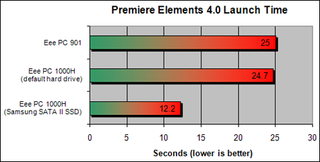
Adobe Photoshop Elements 6.0
Like Premiere Elements, Photoshop Elements is a resource-intensive program that is fairly slow to load. And just as we saw with Premiere, the Samsung SSD opened the program fastest (10 seconds). However, this time the Seagate Momentus hard drive actually beat the pants off the Eee PC 901's SSD by launching the program six seconds sooner (17.7 to 23.8).
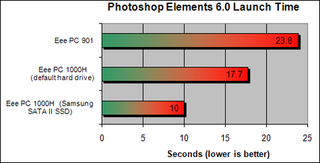
Adobe Reader 8.1.2
Our Adobe Reader launch test was slightly different than our other tests in that we chose to open a large document, the 585-page 9/11 Comission Report, rather than starting the program by itself. We figure that absolutely nobody is going to launch Adobe Reader unless they're using it to open a PDF. Here you can see that the difference between the Samsung (2.5 seconds) and the ASUS-Phison (2.3 seconds) is negligible, but the hard drive is way behind them both (6.1 seconds).
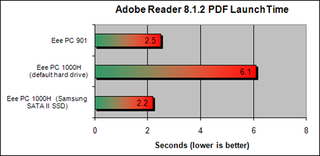
Next Page: More Application Launches, Battery Life >>
Firefox 3.0
The Firefox 3 launch times of the Samsung SSD (2.5 seconds) and the Eee PC 901 (3.2 seconds) were less than a second apart, but the 1000H's hard drive took twice as long.
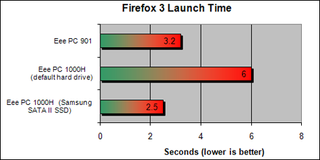
Battery Life
Since SSDs are supposed to draw far less power than traditional hard drives, we were curious whether replacing the hard drive in the 1000H with the Samsung SATA II SSD would increase the system's battery life. Using our Web surfing battery rundown (a macro that surfs the Web continuously on Wi-Fi) on all three systems, you can see that the Samsung SSD improves the Eee PC 1000H's battery life by 20 minutes, but the Eee PC 901 still gets nearly an hour more.
The five and a half hour battery life of the 901 raises an interesting qusetion: does the Eee PC 901 get so much more battery life, because its SSD draws less power than the Samsung SSD or because it has a 9-inch rather than a 10-inch screen? We'll have to wait and get an Eee PC 1000 to find out.
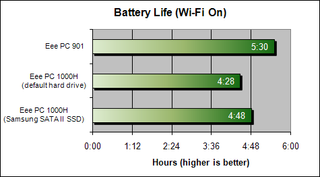
Verdict
While we doubt that anyone would spend between $400 and $1,000 to put a Samsung SATA II SSD in an Eee PC 1000H mini-notebook, this experiment has demonstrated that there is a huge difference in application launch times, boot times, and battery life between even the built-in ASUS-Phison SSD chip you find on the 901 and the standard Seagate Momentus hard drive on the 1000H.
A couple of questions remain, however. First, why do Premiere and Photoshop Elements load faster on the hard drive than the ASUS-Phison SSD? Second, will the SSD-based, 10-inch Eee PC 1000, which we have not received yet, have a battery life closer to that of the 901 or the 1000H? Finally, would replacing the 5,400 rpm Seagate Momentus on the 1000H with a faster hard drive, perhaps a 7,200 rpm drive, make a tangible difference in performance at a much lower cost?

